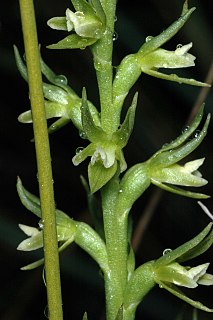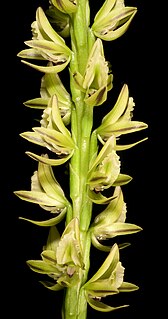
Prasophyllum petilum, commonly known as the Tarengo leek orchid, is a species of orchid endemic to eastern Australia. It has a single tubular, green leaf and up to eighteen pinkish mauve to greenish flowers, well-spaced along a slender flowering stem. It is a small orchid, difficult to locate, generally growing in taller grasses.

Prasophyllum lindleyanum, commonly known as the green leek orchid, is a species of orchid endemic to south-eastern Australia. It has a single smooth, tube-shaped leaf and up to twenty scented, greenish flowers with a greenish or white labellum with a pink tinge.

Prasophyllum brownii, commonly known as the Christmas leek orchid, is a species of orchid endemic to the south-west of Western Australia. It is one of the last of the genus in Western Australia to flower and has a tall flowering stem with up to eighty pale green and fawn-coloured flowers.

Prasophyllum canaliculatum, commonly known as the channelled leek orchid or summer leek orchid, is a species of orchid endemic to a small area of southern New South Wales. It has a single tubular, bright green leaf and up to twenty five scented, greenish-red or brownish flowers on a flowering stem. It grows in woodland at altitudes around 1,000 m (3,000 ft) where only about two hundred plants survive.

Prasophyllum caricetum, commonly known as the Cathcart leek orchid, is a species of orchid endemic to a small area of southern New South Wales. It has a single tubular, bright green leaf and up to twenty five green, white and purplish flowers crowded on the flowering stem. It grows in montane swamps near Cathcart.

Prasophyllum caudiculum, commonly known as the Guyra leek orchid, is a species of orchid endemic to a small area of northern New South Wales. It has a single tubular, bright green leaf and up to thirty five greenish to reddish-brown flowers crowded along an erect flowering stem. It grows in grassy places near Guyra.
Prasophyllum crebriflorum, commonly known as the crowded leek orchid, is a species of orchid endemic to Tasmania. It has a single tubular, dark green leaf with a purplish base and up to twenty five reddish-brown flowers. It is only known from four relatively small populations growing at high altitudes.
Prasophyllum fecundum, commonly known as the self-pollinating leek orchid, is a species of orchid endemic to South Australia. It has a single, smooth, tube-shaped leaf with a reddish or purplish base, and up to twelve relatively small green and purplish flowers. The flowers are short-lived and self-pollinating although attractive to insects.
Prasophyllum gilgai, commonly known as the gilgai leek orchid, is a species of orchid endemic to Victoria. It has a single tubular green leaf and up to twenty greenish brown, light brown, pink or white flowers. It is a very rare orchid with a population of fewer than fifty plants in a small area in the north of the state.
Prasophyllum goldsackii, commonly known as Goldsack's leek orchid, is a species of orchid endemic to South Australia. It has a single tubular green leaf and up to twelve green flowers with dark purple edges and tips. It is only known from two populations on each of the Yorke and Eyre Peninsulas.
Prasophyllum litorale, commonly known as the coastal leek orchid, is a species of orchid endemic to southern continental Australia. It has a single tubular leaf and up to forty flowers with red and green colouring and grows in sandhills near the sea.

Prasophyllum maccannii, commonly known as the inland leek orchid, is a species of orchid endemic to Victoria. It has a single tubular green leaf and up to forty green, greenish-pink or brownish flowers. It is found in the central-west of the state, growing in open forest.
Prasophyllum occultans, commonly known as the hidden leek orchid, is a species of orchid endemic to southern Australia. It has a single, smooth, tube-shaped leaf with a reddish-purple base and up to ten greenish flowers. It is a rare species found only in a few locations in South Australia and in far western Victoria.
Prasophyllum pallidum, commonly known as the pale leek orchid, is a species of orchid endemic to a south-eastern South Australia. It has a single tubular leaf and up to thirty green or yellowish-green flowers. It was previously thought to occur in Victoria but records from that state are now recognised as P. roseum.

Prasophyllum patens, commonly known as the broad-lipped leek orchid or sandstone leek orchid, is a species of orchid endemic to the Sydney region of New South Wales. It has a single tubular green leaf and up to thirty green to greenish-brown, lemon-scented flowers with a white labellum.
Prasophyllum retroflexum, commonly known as the congested leek orchid or Kiandra leek orchid, is a species of orchid endemic to a small area near the border between New South Wales and Victoria, growing in subalpine herbfields. It has a single tubular leaf and up to forty densely-crowded, pale green flowers with pinkish markings.
Prasophyllum roseum, commonly known as the pink lip leek orchid, is a species of orchid endemic to southern continental Australia. It has a single tube-shaped leaf and up to thirty greenish flowers with a pink labellum. It is a recently described plant, previously included with P. fitzgeraldii, but distinguished from that species by its smaller, less crowded flowers, with more spreading lateral sepals and different labellum callus. It grows in the south-east of South Australia and in western Victoria.
Prasophyllum nitidum, commonly known as the shining leek orchid, is a species of orchid endemic to southern continental Australia. It has a single tube-shaped leaf and up to twenty maroon, magenta or purple and green flowers with a pale purple to maroon labellum. It is a recently described plant, previously included with P. fitzgeraldii, but distinguished from that species by its shorter flower spike, glossy flowers and shining, raised labellum callus. It grows in the south-east of South Australia and in a single location in western Victoria.
Prasophyllum tortilis is a species of orchid endemic to South Australia. It has a single tube-shaped leaf and up to ten purplish-brown and green flowers with a purple labellum. It is a recently described plant, previously included with P. fitzgeraldii, but distinguished from that species by its smaller number of smaller, more darkly coloured, short-lived flowers. It also resembles P. goldsackii but has fleshier flowers than that species.
Prasophyllum collinum is a species of orchid endemic to South Australia. It has a single tubular leaf and up to thirty lemon-scented, greenish brown and white flowers. It is only known from the Eyre Peninsula where it grows in sparse woodland.








